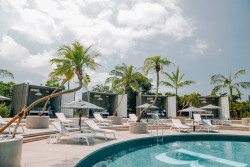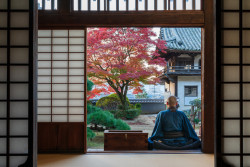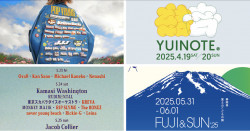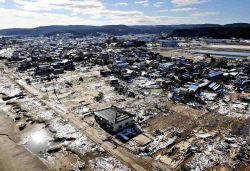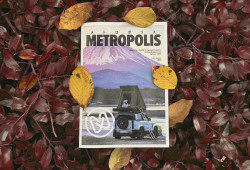
November 25, 2005
On the edge
Hateruma Island offers a primeval slice of sand and surf
By Metropolis
Originally published on metropolis.co.jp on November 2005

Photos by Stephen Mansfield
Compared to the other inter-island craft waiting to shuttle passengers to Hateruma, the battered hull and deck of our small ferry promised a rough crossing. And ten minutes out of Ishigaki Port, the prospect of a wave-heaving passage had indeed come to pass.
It’s all worth it, though, to see this rustic land, out on a limb among the southern Yaeyama Islands of Okinawa, a place where empty roads lead not to hotels and shops, but to an infinity of sea and sky. Hateruma, situated 63km southwest of Ishigaki Island, is little more than 6km in length and 3km at its widest. Its location just a fraction north of the Tropic of Cancer means that visitors can see the lights of the Southern Cross from February to June.
Hateruma means “the end of the coral,” a fitting name given that this is Japan’s southernmost inhabited island—which is perhaps why NTT has a giant receiver tower here, the only visible sign of the 21st century. Nihon Sainantan, erected in 1972 when Okinawa reverted to Japanese rule, is the monument that commemorates the nation’s southernmost point, a cement-and-rock affair stuck on a buff above the cliffs. “Beyond here,” the local maps say, “the Philippines.”

There are few sights as such on the island, less so historical references, although a local, Oyake Akahachi, caused a temporary stir when he rebelled against the royal government in Shuri in 1500. Hateruma has no taxis, hotels or tour groups with flag-wielding conductors; nor are there any of the trappings of the prosperous tourism associated with other Yaeyama Islands like Taketomi-jima, whose water buffalo carts carry visitors through sandy lanes to the sounds of island songs accompanied by the three-stringed sanshin. On Hateruma, you’ll likely hear the tight, scratchy sound of this most Okinawan of instruments, but it will be for the benefit of the player, not the visitor. Where other islands in the Yaeyama group are consciously beautiful, Hateruma seems to do as little as possible to appeal to visitors, a method of inaction that makes it unintentionally more appealing.
A single village is situated in the dead center of the island, a normal precaution in small Okinawan outposts like this. Many of the weathered, one-story houses are clearly prewar. Dark, cool interiors and small flower- and plant-filled yards, some with Chinese-style screen walls made from coral limestone, mark them in the southern Okinawan style. The wooden exteriors have either been left to harden and then peel in the salty air, or painted lime-green or blue. Roofs are of the traditional orange tile variety sealed with white mortar, or blue corrugated iron. The outer and inner stone walls of private residences are replicated throughout the village with more limestone barriers, creating the effect of a maze or honeycomb.
Ghostly banyan trees are confined mostly to the village, where stilt branches support a cool overhead canopy. Elsewhere, fukugi and Indian almond trees are common. Among the island flowers are bamboo orchids, hibiscus and plumeria. Taking root in the sands of Hateruma’s superb Nishi-no-Hama beach are pineapple-like pandanus trees. There are no cement levees here; the sea interacts naturally with the shore.

For divers, underwater Hateruma is a glorious filigree of coral, stone fissures, rock arches and deep blue silhouettes. This is the domain of gold-lined sea bream, redfin fusilier and creatures with suggestive names like the Moorish idol, butterfly fish and rainbow runner. Migratory fish such as the dogtooth tuna and the hammerhead shark can be glimpsed in the spring.
Fishing supplies many of the ingredients for Yaeyama cuisine, but there are other elements as well. Dishes made from goya (bitter melon) are now eaten all over Japan, but what of white radish pickled in brown sugar? Side dishes go well with a glass of invigorating awamori, a distilled rice liquor. Locals have their own, equally lethal brand produced at a tiny distillery here. Few of the slender bottles make it to the local shop though, as villagers buy them all up within hours. This particular firewater is said to be the best accompaniment for yagi-jiru (goat stew), a favorite local dish laced with plenty of garlic.
A bicycle nicely matches the rhythm and pace of this island. I found a rental shop a little way down the hill from the cemetery, where a goat stood peering into the entrance to a tomb whose mortar surfaces were stained black with mildew.
On the main islands, these “turtleback tombs” functioned as wartime hiding places, as well as storage areas for weapons. But here on Hateruma, the dead slept soundly through WWII. Sleep, in fact, plays a part in the island experience, an unofficial siesta descending on Hateruma a little after noon. Slumbering bodies can be glimpsed stretched out over worn tatami inside dimmed rooms, heads molded firmly into beanbags visible above the door stoops where it is cooler.
Apart from the ferries and a minimal number of vehicles and farm machinery, the island sounds are natural, soothing. At one point along the empty road that runs around the island, I stopped my bicycle, stood and listened for any manmade noises, but failed to hear anything.
Only the sound of the wind rattling the sugarcane.
Most travelers reach Hateruma from Ishigaki Island; there are four ferry departures a day from Ishigaki Port, and the journey takes about 50 minutes. Ryukyu Air Commuter has one daily 20min flight from Ishigaki. Minshuku provide Hateruma’s only accommodations. The budget Nishihama-so (0980-85-8290) has kitchen facilities and offers free rice, while Tamashiro (0980-85-8523) is an excellent value, with huge dinner servings. The minshuku also provide shuttle service to and from the port. Just west of the village, directly south of the port, Pananufa is a charming restaurant-café with a library and musical instruments guests can play. There are three or four bicycle rental shops on Hateruma, each charging around ¥1,500 a day. They will provide you with a useful hand-drawn map of the island.
[geo_mashup_map]
